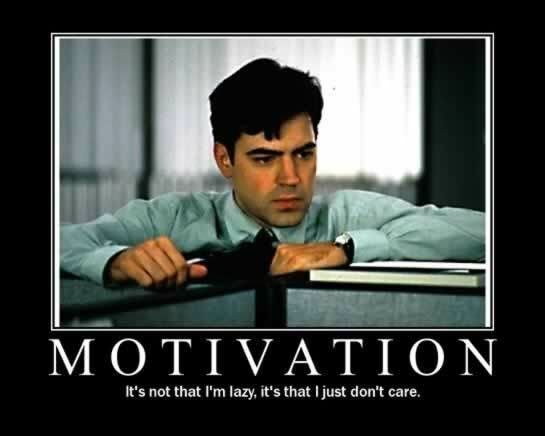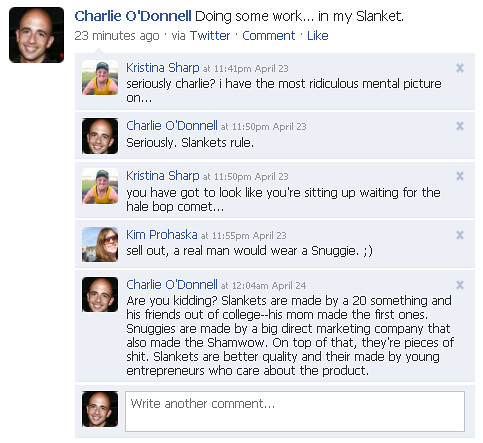Jobfail: Why current offerings are failing both the jobseeker and the recruiter
Ask the average venture investor how excited they are about the recruiting space--you'd get more enthusiasm in the waiting room of a dentist's office. I don't blame them. There are a million "Me, too!" companies and the space is nearly devoid of innovation.
How many ways can you smuch a resume against a job post? Turns out... tons... or really just one, dressed up as tons. On top of that, there is a severe lack of focus on behalf of the job seeker--and if you're not helping people with their career, just what are you doing?
Early in 2008, my partner Alex Lines and I finished raising a small angel round and got to work on building a company called Path101.com. We're a small team working on an innovate approach to career guidance--and we're getting closer and closer to meeting our potential each day, but we're still not there yet.
The career space still haven't solved really basic problems of helping people find jobs and careers--and each year the potential of the technology pushes forward, the industry falls further and further behind. The future is coming much faster than the current players are preparing for it.
It's clear that five to ten years from now--everyone is findable on the web. Every job is nearly already findable through aggregators like Indeed.com and Simply Hired. Just like the market specialists on Wall Street who disappeared when electronic trading came into maturity, many of the players adding friction in the middle of this marketplace will go away. We're seeing this happen on college campuses, where employers are connecting directly with students and visits to career centers are way down. Sure, there may be some people still finding niches to connect people--but surely a lot less in a hyperconnected, seemless world.
What we're heading to, like it or not, is a form of electronic trading markets for people--where exactly who you are and what you can do can get instantly mapped to exactly the company and role that makes the most sense for you and your interests. Unfortunately for most of the existing players--a resume and a job post not the kinds of data infrastructure that will get us there. A resume doesn't tell you nearly enough about who I am and what I can do, and job post doesn't tell me anything about the path that post leads to or what my experience is likely to be in that position. That's why all these "eHarmony for jobs" companies are failing to get the job done. Trying to get everyone in the right place seemlessly with such poor data building blocks would be like trying to run a stock market ticker with refrigerator magnets.
There are all sorts of incentive issues and missteps in the job space. Here are just a few, as I see them, from both sides.
First, here are five ways job sites fail the job seeker:
1) The job boards like Monster, Careerbuilder, and Hotjobs fail to give job seekers the data they need to make adjustments and navigate opportunities. How many people already applied to this job? How does my resume compare to the other applicants? What were people search for when they found my resume? How many views did my resume get? Did anyone even look at it after I sent it in?
 2) LinkedIn is masterful at making you think you should be on there, giving you the impression that you'll be networking, and then having you scratch your head as to what the point is. The problem is that Linkedin has the incentive to get you on, but not have you actually do anything. Don't take my for it... these people were pretty easy to find on Twitter:
2) LinkedIn is masterful at making you think you should be on there, giving you the impression that you'll be networking, and then having you scratch your head as to what the point is. The problem is that Linkedin has the incentive to get you on, but not have you actually do anything. Don't take my for it... these people were pretty easy to find on Twitter:



I personally use it a ton, but if everyone used it the way I do, it would be a noisy mess. Since they broker access to your profile information, the fact that everyone's on it, without really using it, means maximum profits for the company. Sure, they have a section about using it somewhere on the site, but if they really wanted you to get the most out of it, they'd take you right into, "Ok, so let's start contacting some people." Instead, they leave you off right after, "Ok, so let's start adding some people."
 3) Got your resume on VisualCV or Emurse? These resume on the web sites are supposed to help you stand out and get noticed. Sure, they come up high when you Google your own name--but if someone's searching for your name (most likely you), then they already know you and most likely have your resume. What about using these sites you actually get found and contacted?
3) Got your resume on VisualCV or Emurse? These resume on the web sites are supposed to help you stand out and get noticed. Sure, they come up high when you Google your own name--but if someone's searching for your name (most likely you), then they already know you and most likely have your resume. What about using these sites you actually get found and contacted?
Meet Carol Anderson. She has her resume on VisualCV--it won an award as one of the best ones out there. She's a Heathcare Consultant in Fredericksburg, VA. It says so right on her VisualCV. Try Googling for "Heathcare Consultant Fredericksburg, VA". She doesn't come anywhere. In fact, you can't even find her until Page 3 of Google search results for Carol Anderson! Sure, it's a pretty common name, but isn't the point of using one of these profile sites to rise above the rest? You're certainly not going to rise above the rest on Google--VisualCV only has 9,000 pages on it's site exposed to the search engine. Either only 9,000 people have created VisualCVs, or the site is keeping all of the people who joined under wraps--certainly not what people who wanted to "STAND OUT!" and get noticed probably want.
Emurse is a bit better, exposing nearly 200,000 profiles to Google. However, they're not optimized to get you found for much more than searches for your name. Brian Robertson sure wants you to hire him as a freelance web developer, but good luck finding his Emurse resume in Google searches for "freelance web developer st. charles, missouri" on the first page. How many could there be?
4) TheLadders has a great business model...for TheLadders. You pay monthly to see jobs paying over $100,000. It doesn't take a genius to figure out what their incentive is--to keep you on the site as long as possible. If you get hired, you leave and TheLadders loses out on it's revenue. That's not really the kind of model that makes me feel like a site is trying really hard to get me a job.
5) Jobfox tries to be a lot smarter about matching you to the right opening, but unfortunately they suffer from a classic chicken & egg problem. The only jobs you can be matched for with Jobfox's highly scientific approach are openings on Jobfox. In the current economy, those are some pretty slim pickins. It would be better if candidates could see what positions they would be best for even if there weren't positions open in those areas right away. At least they'd have a clue where to look--on other sites.
...and here are five ways job sites fail the recruiter:
1) No site actually understands the full picture of the candidate that the web has to offer versus just aggregating it. Zoominfo just aggregates everything it thinks it found about you (and some stuff it finds about other people) all in one place. LinkedIn doesn't understand that even when you don't write "Python" on your profile, someone with a link to their "py.hack" blog and who tags things python in del.icio.us should come up in a search for Python developers.
2) Search is horrific...everywhere. Try to find the resume of someone with two years of sales experience with a Chemistry major who worked for a large company in a certain geographic area who can speak Spanish. This should be a lot easier--and it's why you tend to get spam from recruiters on job boards. It's not that they want to spam you--they just can't target *and* scale at the same time.
3) No reptuations: A spammy, underhanded recruiter looks the same as a recruiter who takes the time to get to know candidates and send them relevent stuff. In nearly every other kind of marketplace, both buyers and sellers have reputations. Why not in recruiting? (And no, a few "thumbs up" notes in LinkedIn doesn't count--I'm talking something that says 78% of candidates feel that this recruiters offers are relevent).
4) We all know that someone updating their LinkedIn profile and adding people is an extremely strong signal that they're packing up to leave their job. Why not expose this data and let recruiters search on it--maybe even pay a little extra to get out in front of the pack with exclusive access? Recruiting is falling behind in "real time search" and the "now web". The whole thing is based not on the blog post that a social media marketer posted just a few minutes ago, but what someone listed on their resume as their job six years ago--and that needs to change.
5) No "soft" data: We search resumes as if candidates like everything they did in the past and want to do it again---even though we know that isn't even close to being accurate, maybe not even half the time. Doing something simple like asking people if they liked their job would be a huge leap in helping recruiters find people enthusiastic for their offering--not to mention collecting more descreet data about the types of situations they find more satisfying. Now start laying on things like work values, personality, etc., and for a lot of jobs, you might not even care to see a resume.
Have we solved all of those problems at Path101.com? Not yet--but we have key data infrastructure in place. The very philosophy on which we are building out our product and laying out our roadmap is fundamentally about this data-driven, candidate centric future marketplace.
That's one thing that we believe strongly--that unless every single line of code, every business decision, every design choice is made with the jobseeker and their data in mind, you're going to get left far behind. Imagine creating a "green" car company from scratch versus thinking you can make GM green tomorrow. It's probably already too late for the existing players, but this market represents a huge business opportunity for anyone that understands that the candidate comes first and depth of data is your business--and the only way you get there is by getting the candidate to want to give it to you because they're getting something useful back.
What's the last time you got something useful back after submitting your data to Monster.com?
Exactly.
How long do you think that lasts?
My del.icio.us links
Links I've recently tagged on del.icio.us:
Any guess whose kid has the next unwanted pregnancy in North Carolina?
"The Birds and Bees Text Line offers one-on-one exchanges that are private, personal and anonymous. And they can be conducted free of parental scrutiny. That lack of oversight is what galls Bill Brooks, president of the North Carolina Family Policy Council.
"If I couldnt control access to this information, Id turn off the texting service," he said. "When it comes to the Internet, parents are advised to put blockers on their computer and keep it in a central place in the home. But kids can have access to this on their cellphones when theyre away from parental influence and it cant be controlled.""
Mayday! Mayday! Is your career is going down (or sideways...) Take part in Path 101's "Career Mayday" and get help from experts and professionals
 Are you stuck in a rut?
Are you stuck in a rut?
Don't like what you're doing, but can't figure out how to get ahead, or get out?
Ask for career advice on Path101.com on May 1st -- May Day -- as part of Path 101's "Career Mayday" Advicefest.
Path 101 has built up a community of career experts and experienced professionals to help get answers to your most pressing career questions.
What's even better is that when you ask or answer a question, you can connect your Path 101 account to Twitter or Facebook to help get answers from your network. Check out some of these great questions and answers from our site:
Are unpaid internships worth it?
Staying in touch after an interview when there isn't an opening right now
Tomorrow, when you ask a question and connect your Twitter account, the Tweet will look something like this:
Mayday! Mayday! My career needs help! Please help me get an answer to my Path 101 career question. http://bit.yl/32vwesd #mayday Plz RT
When you answer, it will look like this:
Just rescued someone through Path 101's Career Mayday. Save a drowning career, give advice: http://bit.yl/32vwesd #mayday Plz RT
Just make sure you connect your Path 101 to Twitter... After you ask or answer, at the bottom of that question, you can click a link to make a connection. If you ask anonymously, we can't publish the tweet either (but that shouldn't stop you from just asking a question, of course).
Design or accident: How did Tumblr become Tumblr?
When Tumblr first came out, it was promoted as "instant, no-overhead". The post on the Union Square Ventures blog about their first investment in the company is all about personal expression, aggregation, curation. When I first talked to David about it, he stressed the simplicity.
You know what no one seemed to be talking about? The community.
A while back, I recommended Tumblr as a dead-simple blogging platform to a friend. Now, if you're just writing full blog posts and not taking part in the Tumblr community, you'd be a bit of  an odd duck. It would be the 2009 version of someone who decided to write an economics blog on LiveJournal.
an odd duck. It would be the 2009 version of someone who decided to write an economics blog on LiveJournal.
Hmm... LiveJournal. Is Tumblr the new LiveJournal... or LiveJournal for adults?
In both cases, there's clearly something *more* going on than just publishing. In Tumblr, there's a community with it's own social currency--reblogging. Nearly three quarters of my dashboard is reblogs of others. Do my friends only express themselves in relation to others--unable to convey original thought? Or is it a function of how easy this is to do? Was this community behavior evolution or intelligent design?
 The other aspect of services like Tumblr, Vimeo, or Foursquare, for example, that is tough to replicate is the nature of the initial users. Doostang has this attribute as well--although instead of hipster geeks, it started out with private equity geeks. That has not only dictated the makeup of the Doostang community, but has ultimately impacted the business model there as well--the site is now a pay for placement recruiting service.
The other aspect of services like Tumblr, Vimeo, or Foursquare, for example, that is tough to replicate is the nature of the initial users. Doostang has this attribute as well--although instead of hipster geeks, it started out with private equity geeks. That has not only dictated the makeup of the Doostang community, but has ultimately impacted the business model there as well--the site is now a pay for placement recruiting service.
So, what is Tumblr? Is it the application? The people? An emergent behavior? Can it be replicated?
My recent tracks on Last.fm
The most recent tracks I've been listening to on last.fm:
Path 101 acquisitions
Firesale at a nearby startup. We bought some computers at 15 a piece to add to our crawling infrastructure... The cart we just found on the sidewalk.
Path 101: Mint.com for your career
Sometimes, it takes you longer to realize things about your own business--especially somewhat obvious (in hindsight) business analogies.
I was thinking about Mint.com, the personal finance site, and I never realized how similar our goals are at Path 101.
Mint is building a suite of free tools to help manage a mainstream problem that effects everyone--in their case, managing your budget. Their target audiance? What about... everyone who makes money? Spends money? Wants more money? It's a pretty huge potential audience and we feel the same way about our career guidance site. Path 101 is targeted at anyone who works and wants to figure out what's next.
Now, the argument could be made that not a lot of people who make money actually manage their money well, which is what I thought initially about Mint. However, Mint is making their tools so easy that they're not just converting the beancounters, they're helping people who have never ever kept a budget before--introducing people to the concept of budging and personal financial management. We want to do the same for careers. Thinking about your career can be an intimidating thing and we want to shed some light on the process and make it easier.
Mint.com makes it easy for you to upload your financial data to the system, but moreover they give you a compelling reason to--to get recommendations and gain insight into your budget, the same way we want someone to get value from uploading their resume and other information.
This enables Mint to gain a tremendous information advantage from a business standpoint. By working hand in hand with their users in managing their finances, they are the best positioned to broker offers from people who want to access those users. That's ultimately where we want to be with Path 101. By getting to know our users better, because we helped them manage their career, we'll ultimately be the best place to broker recruiter and employer access--particularly given that we'll know so much more about each user.
They're also using the network effects of having all that user data to improve the product. The more Mint users there are, the more insight they get into trends and norms, which can, in turn, be presented back to the user in a useful, comparitive way.
It's a business and product model that no doubt works in other areas, too, but I feel like Mint is a particularly relevent comparison given the size of the potential market, the importance of this aspect of someone's lifestyle, and the focus on data.
I'm thinking she died for a reason...
I wrote a post about losing our family dog that now has nearly 100 comments on it...mostly dead dog stories.
Listen to this story...
"well i had a dog in kindgarden threw 4th grade and it was hit by a car in those grades i didnt have any friends and it was my only friend i would talk to her i would pet her for hours she was my only and best friend i loved her dearly the day i was told she died i cried for months but right after she died i made my human best friend and then other and now im 13 and have alot of friends and im thinking she died for a reason. R.I.P buttercup"
My del.icio.us links
Links I've recently tagged on del.icio.us:
When did your investors start using your service?
I found this neat little viral app, When did you join Twitter?
Apparently, I joined on February 12, 2007... and then about a month later, I totally got it.
This is a note I wrote to Fred Wilson... note the date:
From: Charlie O'Donnell
To: Fred Wilson
Sent: Fri Mar 09 10:44:03 2007
Subject: Do you twitter?You should check it out... I didn't get it at first, but now that there's a group going to sxsw, I get it. Its like an OS for sms. I'd never text all the people I'm texting now...but its a really seemless way to text groups and inidividuals at the same time.
It needs to be packaged for the MySpace gen better, and also marketed to groups and conferences. I'm connected to the sxsw group and they randomly connected me to two other twitter people in a 3 person group. It can solve the prob of walking into a conf and not knowing who the heck to meet or talk to first.
What's even better... check this out:

So basically, what we can take from this is that it takes Fred three days to act on e-mails and four months to invest.
5 things I learned at Social Foo
1) Great hiring is partly function of how many people you put into the top of the funnel. You won't put extra pressure on yourself to hire anyone you don't feel great about, because you know you'll see more, and it will help you get a good sense of what you're looking for.
2) Take feature suggestions out of the hands of executives. Instead, make problem/opportunity identification their job and let the process figure out the solutions through testing and data.
3) Slankets are awesome. Path 101 got Gary Clegg at The Slanket to hook up every single SocialFoo attendee with a Slanket. We thought it would be appropriate because it gets cold at night in Sebastopol, plus, as you can see, Slankets are an important part of the social graph:
4) At the end of the day, the most successful people are those that are dedicated to building really great stuff, not the people who worry too much about beating the competition--collaboration FTW!
5) Building a few deep connections with people is better than trying to network at scale. This is the same reason I love SXSW. When you can hangout with people in your industry in a relaxed social setting, you get to know them a lot better. They become people versus just business cards or Twitter icons. I greatly enjoyed getting to know the folks I met at SocialFoo and look forward to hopefully running into them again soon.
My recent tracks on Last.fm
The most recent tracks I've been listening to on last.fm:
My del.icio.us links
Links I've recently tagged on del.icio.us:
I tagged it with: outplacement




![Reblog this post [with Zemanta]](http://img.zemanta.com/reblog_e.png?x-id=25039263-1d14-48bc-a83a-8609051aec86)




